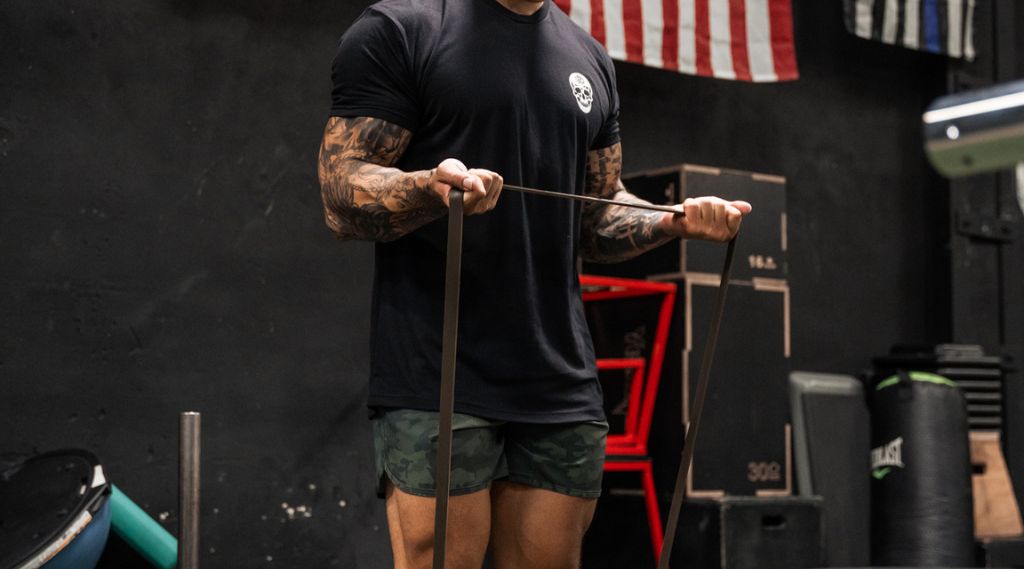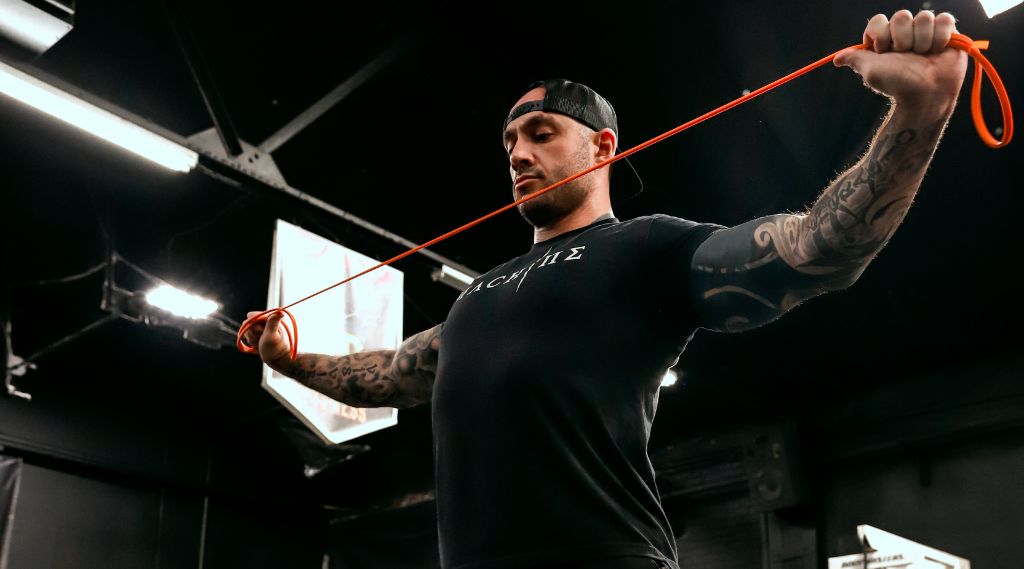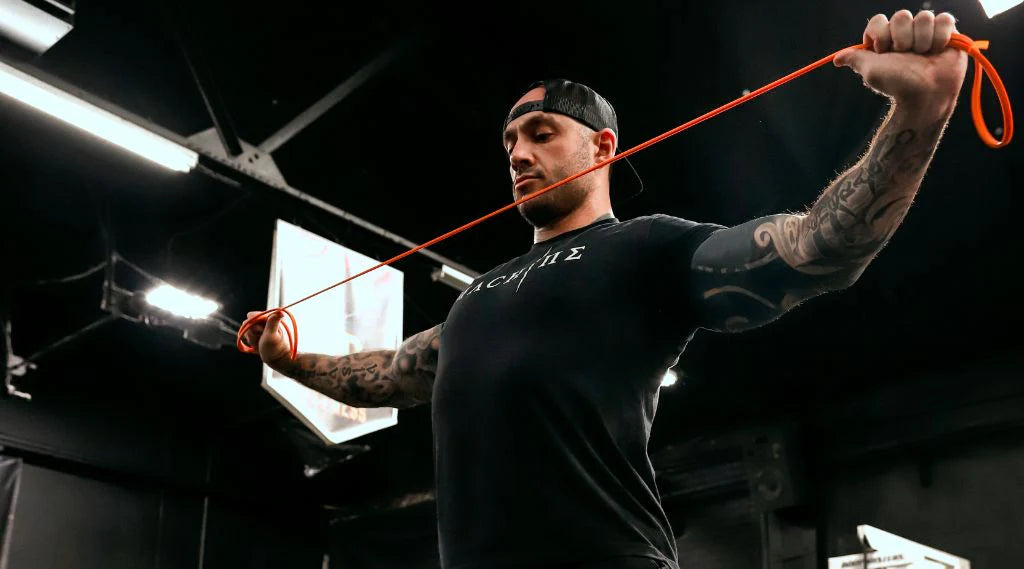You might think that growing your biceps with resistance bands is impossible, but you would be wrong. Training your biceps with resistance bands can trigger growth by providing a different stimulus than you can achieve with free weights or cables.
Some of the best resistance band bicep exercises include standing curls, wide-grip curls, hammer curls, reverse-grip curls, Bayesian curls, and band-assisted chin-ups. Including some of these in your training will develop both bicep heads, the brachialis, which lies underneath the bicep, and your brachioradialis.
Knowing how to perform these and other movements with a resistance band is crucial for getting the right amount of tension to improve muscle activation, grow, and reduce the risk of injury.
Key Takeaways
- The biceps, which have a long outer and short inner head, make up the front upper portion of the upper arms and are responsible for elbow flexion and wrist supination.
- Performing bicep exercises with a resistance band can lead to greater activation and intense peak contractions because of increased tension as the band stretches.
- To perform bicep exercises correctly it’s important to keep the elbows stationary and allow the forearm to rotate about the joint.
Anatomy of the Bicep Muscles
The biceps, also known as biceps brachii, are two-headed muscles that make up the upper front portion of the arms and are primarily responsible for:
- Elbow flexion (bending the arm)
- Wrist supination (rotating your wrists out)
The muscle consists of a short inner and long outer head that run parallel and work together during all activities that involve the biceps.
Both bicep heads originate from the scapula (shoulder blade) and insert into the elbow, which means your shoulder position can influence bicep activation.
For example, having your arms behind your upper body, such as during an incline dumbbell curl, emphasizes the long bicep head and leads to a more significant stretch.
Traditional bicep curls are the simplest way to train the biceps, but you can also target these muscles with compound pulling movements because they require elbow flexion. Such activities include bent-over barbell rows, pull-ups, and lat pulldowns.
Also worth mentioning is the brachialis, a deep muscle that lies underneath the bicep and assists with elbow flexion. When developed, the brachialis pushes the bicep up, leading to a more prominent peak.
Benefits of Training the Biceps With Bands

Here are five reasons why you should do at least some of your bicep work with bands:
- Stronger bicep contractions. Bands have linear variable resistance (LVR), which is a fancy way of saying they offer more resistance as they lengthen. The gradually increasing resistance makes the top portion of bicep exercises more challenging, forcing the biceps to contract harder than they would using cables or free-weights.
- Greater muscle activation. Bands can be an excellent alternative to free weights for improving muscle activation and helping lifters establish a mind-muscle connection with their biceps.
- Constant tension. Bands keep your biceps engaged throughout the entire range of motion, never giving them time to rest. In addition to supporting muscle activation, constant tension can lead to a stronger muscle stimulus, potentially resulting in more growth.
- Increased potential for overloading. Bands cover a range of tension levels, which means you can select the resistance that fits your abilities. You can use these different levels of resistance to add more volume and intensity to your bicep training by incorporating drop sets or supersets.
- Low risk of using momentum. Free weights make it easier to swing your body and lift more weight by “cheating the movement”, which isn’t ideal.
In contrast, since bands provide more resistance as they lengthen, it’s more difficult to use momentum because the initial force wouldn’t be enough to continue stretching the band and overcoming its increasing resistance.
Related Articles:
- Best Forearm Exercises & Workouts With Bands
- Best Core Exercises With Bands (+ Sample Workout)
- Best Neck Training Exercises With Resistance Bands
9 Best Bicep Exercises With Bands
1. Standing Band Curl
The standing band curl is a simple and effective movement you can perform with a looped or open-ended resistance band. Having the palms positioned forward keeps most of the tension on the biceps, as opposed to the forearms.
How To Do Standing Band Curl
- Step on your resistance band with both feet and grab the other end of the band in both hands.
- Stand tall, bring your chest out, and rotate your wrists out for your palms to face forward.
- Engage your abs and inhale.
- Bend your arms slowly until your wrists are slightly higher than your elbows. Keep your elbows glued to your sides, not allowing them to travel forward or back as you do reps.
- Pause briefly at the top and slowly extend your arms back to that starting position as you exhale.
Pro tip: To increase the amount of resistance without changing bands, step your feet further apart and/or cross the band into an “X” before gripping it as normal.
Related Article: 10 Best Tricep Exercises With Bands (+ Sample Workout)
2. Wide-Grip Band Curls
The wide-grip band curl is identical to the previous movement, with the primary difference being that your forearm position is shifted to the side. Pointing your forearms outward during a curl emphasizes the short (inner) bicep head.
How To Do Wide-Grip Band Curls
- Take an open-ended band and step over the middle.
- Grab the handles, stand tall, bring your elbows to your sides, and point your forearms forward and out.
- Take a breath and bend both arms, squeezing your biceps at the top.
- Slowly extend your arms and exhale.
Pro tip: Do each repetition slowly and with good control, extending your arms fully on the way down and squeezing your biceps in the top position, ensuring the elbows stay stationary.
3. Close-Grip Band Curls
In contrast to the previous movement, using a close grip allows you to focus more on the outer portion of the bicep––the long head.
How To Do Close-Grip Band Curls
- Take a looped band and step over its middle.
- Cross the band so it forms an “X” then grab the band with both hands, lean forward slightly, and position your elbows in front of your stomach with your hands a few inches apart.
- Engage your abs, breathe in, and bend your arms slowly, squeezing your biceps at the top position.
- Hold briefly and slowly extend your arms fully as you exhale.
Pro tip: To increase the difficulty of this movement without changing bands, step your feet further apart.
4. Band Drag Curl
The band drag curl forces your elbows to travel behind your body, which can lead to greater long-head activation. I prefer to do the drag curl using a band attached to a dowel or PVC pipe, but you could also do it with the band by itself.
How To Do Band Drag Curl
- Grab a looped resistance band, and loop each end over a dowel, PVC pipe, or even a broom handle.
- Step down on the middle of the band with both feet. Stand tall and hold the dowel (or other equipment) in both hands with your palms facing away from you.
- Bring your chest out and engage your abs.
- Take a breath and bend your arms, dragging the dowel against your stomach and allowing your elbows to travel behind your body.
- Squeeze your biceps at the top position, hold momentarily, and extend your arms back down to the start position as you exhale.
Pro tip: Try to keep your wrists neutral to prevent them from bending backwards as you perform the rep. Additionally, do a slow eccentric (lowering) phase to keep tension on your biceps and improve the mind-muscle connection.
5. Band Hammer Curl
Hammer curls are a variation where you keep your wrists neutral (palms facing one another). The neutral hand position of the banded hammer curls emphasizes the long bicep head, the brachialis, and the brachioradialis (a forearm muscle).
How To Do Band Hammer Curl
- Grab a looped resistance band with both hands.
- Lean forward and step over the opposite end of the band.
- Stand tall and position your arms to your sides with your palms facing your thighs.
- Bring your chest out, take a deep breath, and bend your elbows until your wrists are slightly higher than your elbows.
- Pause at the top position and slowly extend your arms as you exhale.
Pro tip: Keep your elbows locked at your sides to improve bicep activation. Moving your elbows forward and back can shorten the range of motion, making the movement less effective.
6. Band Reverse-Grip Curl
Reverse-grip curls are a variation where you bend and extend your elbows while having your palms facing downward (pronation). This hand position increases forearm activation while also working the biceps.
How To Do Band Reverse-Grip Curl
- Grab a looped band with an overhand grip (palms facing down).
- Step over the opposite end of the band.
- Stand tall and position your elbows to your sides.
- Take a deep breath and bend your arms slowly while keeping your elbows to your sides.
- Pause briefly at the top, squeezing your biceps.
- Slowly extend your arms as you exhale.
Pro tip: Try to keep your wrists neutral as you pull the band upward into the curl to keep the focus on your biceps.
7. Band Crucifix Curl
Band crucifix curls are an excellent single-arm exercise that improves bicep activation. To perform these, you must raise your arm to the side, bringing your elbow to just below shoulder level.
How To Do Band Crucifix Curl
- Attach a looped or open-ended band in a high position––for example, by using a door anchor or looping one end over the top of a squat rack frame.
- Grab the bottom portion of the band with one hand, stand sideways, and take a few lateral steps away to stretch out the band.
- Raise your arm to your side, bringing your elbow to shoulder level.
- Bring your chest out, engage your abs, and inhale.
- Bend your arm, bringing your hand closer to your head, and pause momentarily.
- Slowly extend your arm and exhale.
- Once finished training one bicep, turn to your other side, and do the same number of reps for your other arm.
Pro tip: A full range of motion means bringing your fist an inch or two from your face before fully extending your arm to the side.
8. Band-Assisted Chin-Up
Chin-ups are a compound exercise that primarily trains the back. However, because of the grip, the activity is also highly beneficial for the biceps, allowing trainees to target the muscle group with more weight.
How To Do Band-Assisted Chin-Up
- Wrap one end of a looped resistance band over a horizontal pull-up bar. The other end of the band should hang like a noose. The thicker the band is, the more it helps during pull-ups.
- Step over the band with one or both feet, reach up, and grab the pull-up bar with an underhand grip (palms facing back). Your hands should be shoulder-width apart.
- Bring your shoulders back, take a deep breath, and engage your abs.
- Pull yourself up in one fluid motion, bringing your chin over the bar. Squeeze your biceps at the top.
- Slowly lower yourself and exhale.
Pro tip: Don’t rely too much on band support. The band should offer some help but make sure your back and biceps are still doing most of the work. It shouldn’t feel like the band is skyrocketing you over the bar.
9. Bayesian Band Curl
The Bayesian curl is an effective bicep exercise created and popularized by Menno Henselmans. With this curl variation, the band is anchored behind your body, which stretches the bicep significantly and could trigger more growth.
Menno’s advice is to:
“bend forwards slightly as you flex your biceps to get a good full contraction. Then you lean back again as you lower the weight to fully stretch the biceps."
-Menno Henselmans, physique coach, researcher, and best-selling author
How To Do Bayesian Band Curl
- Attach a looped or open-ended resistance band somewhere low. You can tie one end on the leg of a couch or use a door anchor.
- Grab the opposite end of the band with one hand and turn away from the attachment point.
- Take a couple of steps forward to stretch the band, stagger your stance, and allow your arm to be pulled behind your upper body.
- Stand tall, breathe in, and bend your arm, squeezing your biceps.
- Pause briefly and extend your arm as you exhale.
- Once finished training one bicep, grab the band with your other hand, and do the same number of reps.
Pro tip: Keep your working arm behind your body from start to finish. Resist the urge to bring your elbow forward as you bend your arm for each repetition.
Sample Bicep Workout Routine With Bands
Here is an effective resistance band bicep routine you can do with some of the above exercises:
|
Exercise |
Sets |
Reps |
Rest Period |
|
Band-Assisted Chin-up |
3-4 |
To failure |
150-180 seconds |
|
Band Hammer Curl |
3 |
12-15 |
90-120 seconds |
|
Wide-Grip Band Curl |
3 |
15-25 |
60-90 seconds |
If you’re training your biceps multiple times per week, then make an effort to switch up the exercises on different days to ensure you’re targeting your biceps from all angles.
Best Bands For Training Your Biceps

I recommend the Gymreapers Military Resistance Band Set for effective bicep training at home and on the road. These bands are ideal for pumping up the bicep for three reasons:
- You can use these bands for all nine of the exercises I discussed and many others. You can pick from dozens of effective movements for your biceps, triceps, shoulders, and most other major muscle groups.
- Each band covers a specific tension range, allowing you to adjust the resistance to fit your current abilities.
For example, the lightest band offers up to 35 lbs of resistance, and the remaining four go up to 60, 80, 120, and 150 lbs. You can challenge yourself now and provide the necessary overload as you get stronger.
- These bands are light and compact, which means they won’t take up too much space if you have a small home gym and they are easy to take with you when you’re traveling. The set also comes with a bag, providing a convenient storage option.
Plus, the Gymreapers bands are made of high-quality elastic material and will last a long time, even with regular use.













Leave a comment
All comments are moderated before being published.
This site is protected by hCaptcha and the hCaptcha Privacy Policy and Terms of Service apply.